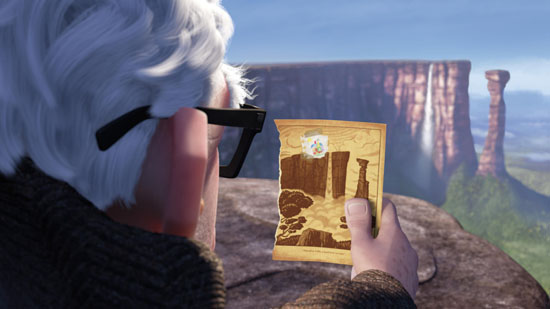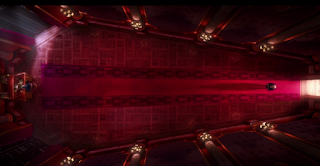Today in screenwriting class we watched a short animation called Partly Cloudy and I decided to do my post on this animation because the flock of birds reminded me of what we did in class on Monday and because I really enjoyed watching this.
Here are some parts from an interview that
explain the animation process that I found very informative and great to read.
I especially liked how they created the cloud to seem realistic but ‘floaty’
and see-through at the same time. I also provided link to watch the short animation,
the ones I found on YouTube were recreated with new soundtracks so I had a hard
time finding the original.
PS: The original pitch was just as
I explained: There's the world of storks that deliver babies, but where do they
get these babies from? And my answer was obviously the clouds. And I had done
some drawings of these cloud characters -- taking some photos and Photoshopping
eyes and a nose in and then having some birds all flocking up to the skies. I
pitched this story of a smaller gray cloud that [lived below and] made some of
the dangerous babies. And I showed John these images and he touched on one of
them and said let's start developing this one.
And that was close to a year-and-a-half ago and it's been a
really interesting learning experience for me. Obviously, this is my first
[short]. It really is like raising a baby. I felt very much like Gus during
this thing -- making something and wanting people to like it.
Sohn
pitched the idea a year-and-a-half ago, visualizing where baby-delivering
storks actually get their babies from and picturing clouds creating them out of
thin air.
BD: How did you find the tone?
PS: I always wanted to have
something with heart. And what I mean by heart is characters that are sincere
in what they are doing. That was something I had to really look for and find.
There were many different tonal characters. Gus was more like a bartender or a
frat guy. And Peck went up and down. But ultimately it came down to being a
story about miscommunication when I originally pitched it to John. I had grown
up in New York and from Korean parents and they spoke very broken English and
there were always miscommunications between my mother or father and me. So,
from the very beginning, it was: How do these two guys work, a bird and a
cloud? That miscommunication idea is a subtle thing: most of the shorts around
here don't have any dialogue, but I really wanted to play with how they
communicate with each other. And the way Gus looks off at the other cloud
[Gloria] was inspired by my mother's reaction when I was going out to play with
my friends. She would take it a certain way. That didn't change but how I moved
the characters around did.

Peck
and Gus in their early stages.
BD: Let's talk about the animation,
which is obviously very cloud-driven.
PS: The animation is heavily based
on rhythm and timing... but to describe how a cloud moves was a huge hurdle for
us because the short needed to be snappy. And we did tests of Gus moving sharp
and crisp, but it just didn't feel like a cloud. And we had to slow him down
and get him to be floaty and have his nose and exterior parts move in a certain
way and keep the crispness with Peck. So there were many experiments we did
with him without even the cloud effect on him: "naked" Gus, who
looked kind of like the Michelin Man. And a couple of animators [Matt Strangio
and Dylan
Brown] found this really amazing style of keeping him floaty: he
doesn't stop ever, he just moves around. John Lasseter had a great call of that
where he overshoots his overlap but doesn't rubber band back. He just floats
out to that extremity and comes back. That call gave us a great place to shoot
for with Gus and we experimented a lot with that and then added the cloud
effect on top of that really helped sell Gus' look.
BD: How was this achieved
technically?
PS: Gus is literally wearing a
200,000-particle suit. Because he had to be kept transparent, we have an invisible
character that we animate that we turn off, essentially, and leave the suit on
that we never get to see until later. The suit pretty much looked like a lint
guy when we were using him because a cloud is basically moisture and light and
the final lighting process is what brought him to life. It wasn't just the
cloud movement but how soft the shadows are, how the light works underneath him
and what kind of detail we get in the shadows. But he was really an amazingly
difficult character to build. In the beginning, when I first pitched this to
some of the technical folks, they gave you a lot of options and different
"Yellow Brick Roads" to what Gus would finally look like. There was a
gaseous-looking Gus and a ghosty-looking Gus. We came up with this version that
was more of a caricatured puffy cloud. Sort of like Ralph Kramden from The Honeymooners.
The really tough challenge was that, because he is transparent and made up of
so many particles, the rendering and lighting times are really long. It was a big
fear that we wouldn't have enough time to render this short.

Animators
Matt Strangio and Dylan Brown found a style of keeping Gus floaty and
see-through. This is achieved by having Gus wear a 200,000-particle suit.
BD: But obviously you did. What
were some of the other challenges?
PS: What I loved about it was we
were using techniques in a new way that no one had ever done before in the
lighting and in the particle world like blending shadows. But it was so hard to
sell his eyes and his mouth. They were so soft that you could hardly read what
was going on the face or the hands. We had to do some tweaks to finally get a
smile on his face. And we tried cloudy eyes and it looked scary. Or it was
difficult to make the eyelids work. Because the cloud effect is so thin, when
he closed his eyes you could still see the eyeball beneath it. We just wanted
someone appealing and really cute. And we came up with these eyes and mouth.
BD: And was any of this repurposed
for Up?
PS: No, actually we took something
from Up.
A storm sequence was tweaked for our own purpose. It was lucky that this
technology had just been achieved.
BD: What about the color palette?
PS: I always wanted the short to
take place in a day: it starts in the morning and ends in the evening. But Noah
Klocek, the production designer, brought it to life with the pastels that he
had done so that morning and sunset can look exactly the same. So he
caricatured it to look really warm and golden for that classical drop of the
storks and toward the evening to come up with a look that is its own kind of
world. It's so abstract that you want it to be believable, but you also want to
caricature it so that every time you saw those colors it would be iconic in a
way. And then Tim Best and his lighting crew translated that and brought it a
whole new level. It was really surprising for us because there were so many
times when we were working that we don't even see the clouds above or Gus in
the cloud form. When the lighters come in, which are the last few months, that's
we finally get to see Gus and the world.

The
pastel color palate moves from sunrise to sunset over the course of the short,
keeping the look iconic but also abstract enough to look believable.
BD: And what about the storks?
PS: I really love the Dumbo storks in the beginning and was trying
to get that realistic feel. There are really two Dumbo storks: the realistic storks in the
beginning and the cartoony stork that actually delivers Dumbo. It was a mixture
of both extremes: the realistic and finding how to caricature the stork's eyes
to get the appealing faces from far away when they're flying in.
BD: And the babies?
PS: It was funny because JL kept
saying to make them as cute as possible, even the more dangerous animals,
because you want them to be the cutest things you'll ever see. We really tried
pushing them and caricaturing them and that's what sold them.
Gus
thinks even his most dangerous babies are loveable.
BD: And what was it like working in 3-D?
PS: We've just done some of the
right eye rendering the last couple of weeks, and that's what forms the 3-D.
That world of 3-D has been really amazing. It's fun but it's a whole other set
of challenges. You really feel like you're up in the sky in 3-D. It falls
really far back in the depth, but you also want to focus where the audience's
eyes go, and sometimes Gus' shoulder will be way in the foreground and you'll
start looking at his shoulder instead of [what we want you to focus on]. It's a
real balancing act of where the focus plane lies on the 3-D. But it was very
successful and it's a really crazy thing to fly up there in the clouds in 3-D.
































